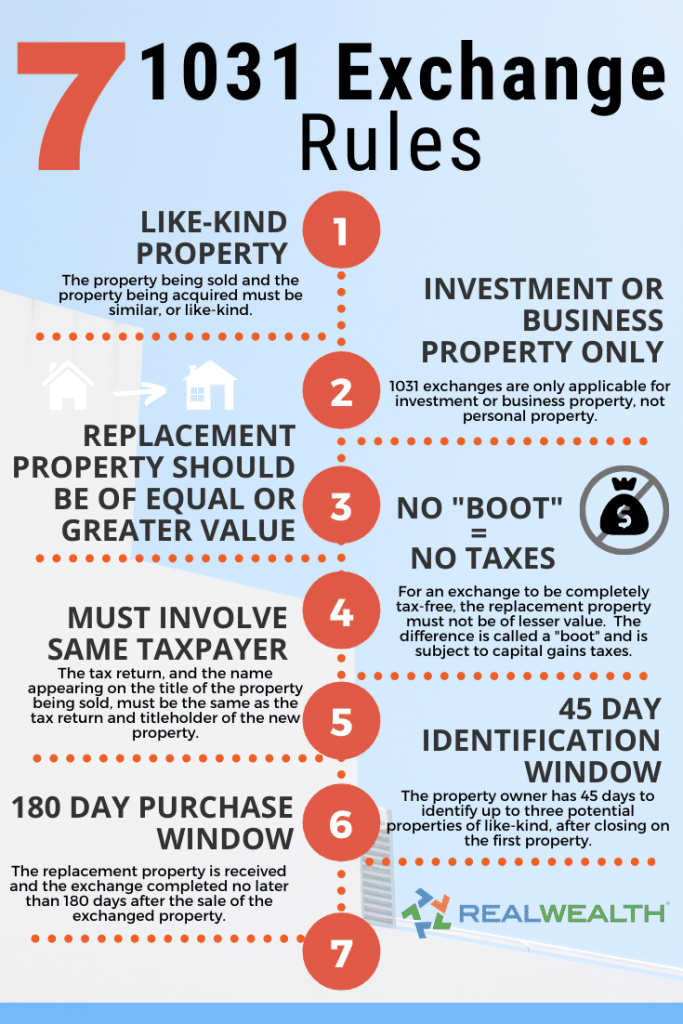Table of Contents
1031 Exchange 3 Property Rule – 1031 Exchange Rules 2021 is a property term that refers to the swap in financial investment residential or commercial property in order to delay tax obligations of capital gains. The name is gotten from Section 1031 of the Internal Revenue Service code, which describes financiers, realtors, and title companies.
There are plenty of dynamic parts within Section 1031 that important to be recognized prior to you try to use them. Exchange can be done just for “like-kind” residential properties and the uses are limited for vacation residential properties by IRS. There also exist implications of tax obligations as well as time frames that could be turned against the individuals. For that reason, if you still want to discover the rules, proceed to check out the list below passage.
What Are 1031 Exchange Rules?
As pointed out in prior, 1031 exchange is an act of swapping investment properties. It is likewise generally described as Starker or like-kind exchange. The majority of swaps apply for tax obligations as sales, however, you might delay tax or provided with limited tax obligation if you can satisfy the 1031 exchange’s requirements.
As an outcome, according to IRS, you will be able to alter the investment types without the financial investment being recognized as capital gain or being cashed out. 1031 is basically can be done for unlimited amounts of times. You might not obtain revenue from every single swap, however, you will stay clear of tax obligation until the investment is marketed, even if it takes years later on.
The 1031 Exchange Rules 2021 is utilized for the property of the organization and also for financial investment only. However, it could be able to apply to the primary residence property under some conditions. It is additionally actually feasible to use 1031 for vacation properties, yet the opportunity is so low currently contrasted to long times back.
What Are Types of 1031 Exchange Rules?
Simultaneous
Simultaneous exchange happens is the like-kind exchange occurs within the very same day. This is the initial 1031 exchange kind until the law of tax obligations is upgraded to permit the possibility for various other kinds.
Delayed
Delayed exchange happens if you market the residential or commercial property, receive money, and purchase one more residential property by delay. The delay may occur for a solitary day to a couple of months before you finally acquire the replacement residential property. If the substitute residential or commercial property is not acquired within the IRS’ determined period, then you require to pay your residential or commercial property sale’s capital gain.
Improvement
Known as building exchange, Improvement exchange happens when you desire to utilize tax-deferred cash to improve the substitute residential property. However, the cash is kept by the middle man.
Reverse
Reverse exchange occurs if you buy the property first, and afterward exchange it later. In this circumstance, you require to purchase the replacement property first after that arrange the second residential property’s sale. This kind of exchange is not actually usual to be made use of, due to the fact that the bargains require to be totally in money.
Delayed Exchanges and Timing Rules
There are 2 timing rules that fundamentals and also have to be observed throughout the Delayed exchanges:
45-Day Rule
The rule is connected with the visit of the substitute property. The middle guy ought to get the money once the residential or commercial property purchase occurs. You ought to not receive the cash money as it’ll damage the 1031 exchange.
Within the span of 45 days after the residential or commercial property is offered, the replacement residential or commercial property needs to be assigned to the middle male, and also the property that you want to acquire ought to be defined. According to IRS, you might assign up to three properties, as long as you are nearby to among the three. If they fulfill with particular appraisal tests, it’s also feasible to designate past three residential properties.
180-Day Rule
The timing rule relates to closing in the context of a Delayed exchange. The new residential property must be closed in the span of 180 days after the old is sold.
1031 Exchange 3 Property Rule
The Three Property Rule is identified below IRC Section 1031, which states that the exchanger or taxpayer carrying out a postponed trade has 45 schedule times from your shutting date from the sale of the relinquished property to officially determine a substitute property or properties.
Underneath the Three Property Rule, the exchanger might determine as many as three properties, irrespective of worth, so long as she or he acquires one from the three because the substitute property inside the 180-day trade time period.
Utilizing the Three Property Rule, a trader doesn’t need to worry about the recognized properties’ reasonable market price. If, however, the trader would like to determine a lot more than three properties, the Three Property Rule no more is applicable, and they are going to slide into the 200 Percent Rule. This rule states the recognized properties’ aggregate worth can’t surpass a lot more than 200 Percent from the relinquished property’s worth.
IRC Section 1031 Fact Sheet PDF
 Loading...
Loading...
HOPE THIS SHORT ARTICLE HELPS YOU!
IF YOU ARE STILL HAVING TROUBLE OR CONFUSED ABOUT [KEYWORD], YOU MAY CONSULT WITH A TAX EXPERT THROUGH THIS LINK OR WITH A FINANCE EXPERT THROUGH THE CHAT BOX RIGHT BELOW.
